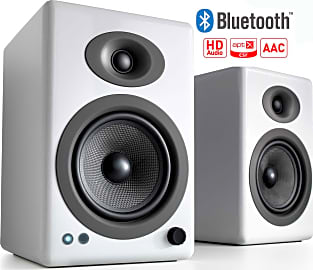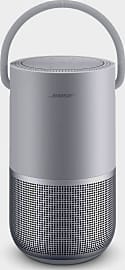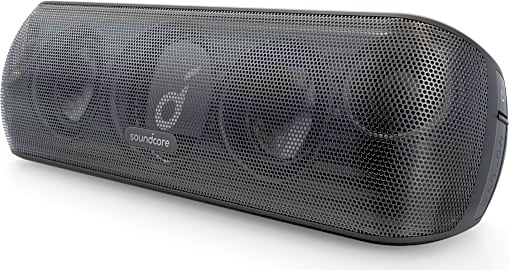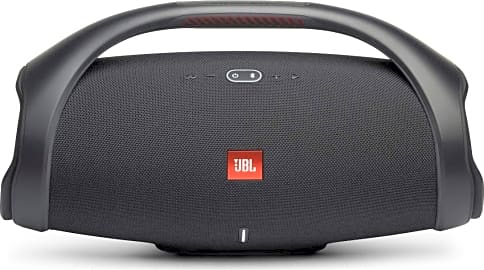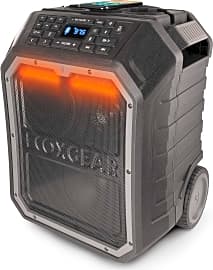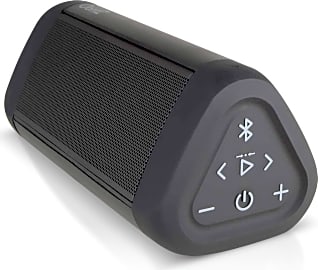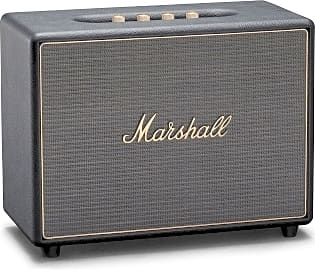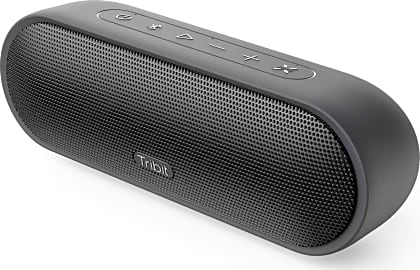The 10 Best Bluetooth Speakers

This wiki has been updated 39 times since it was first published in March of 2015. If the sound you're getting from your earbuds is just not cutting it, or you want to share your awesome musical taste with friends, these Bluetooth and WiFi speakers offer great sound and are reasonably priced. There are both portable and stationary options, and they can all connect wirelessly. Many are even water-resistant or waterproof, too, so you can take them anywhere. When users buy our independently chosen editorial selections, we may earn commissions to help fund the Wiki.
Editor's Notes
November 24, 2020:
We made considerable changes to this list, including updating the Sony XB41 to the Sony XB43. This is the newest model from Sony, with an updated speaker arrangement that includes an additional tweeter and dual passive radiators. With the addition of the new power-saving mode, it retained the Extra Bass mode and Live Sound mode. The speaker's superb capabilities in supporting LDAC has kept it at the top spot.
The Bose Soundlink+ was updated to the Bose Smart Speaker. Bose made a massive improvement as the new model now supports Alexa and Google Assistant, working with the rest of the company's line of smart home speakers. While the older model seemed a bit pricey for what it was capable of, the new model has stayed around the same price point, despite its major upgrade. For this reason, we placed the Bose Smart Speaker higher on the list.
We decided to include the Oontz Angle 3 Ultra for its modest price point and reliability. The JBL Boombox 2 was added to the list for those wanting a speaker capable of high volume but without the bulk of the EcoGear EcoBoulder Max.
November 28, 2019:
There are a few different classes of Bluetooth-enabled speakers that warrant plenty of interest. The Ultimate Ears WonderBoom 2 is part of the most portable class, as it's easy to fit in a backpack and sounds great; in fact, its bass output is considerably louder than what you might expect from a device of its size. The Anker Soundcore Motion+ is a bit slimmer, and almost as loud, and supports the AptX codec so you won't fall prey to compression dampening your sound quality. The JBL Xtreme 2 Is a bit larger, and with that size comes increased volume, bass, and of course price. For maximum portability, check out the Tribit XSound Go, which takes up very little space but still plays music quite well.
If you don't need to stuff in quite so small a bag, the Bose Soundlink+ provides the high-fidelity audio you'd expect from such a prominent name in electronics. We really like the Sony XB41 because not only does it have powerful drivers and plenty of space for the bass to reverberate, it uses the company's advanced LDAC codec, which owners of almost any Android smartphone made in the last 2 years can take advantage of. The vast majority of music listeners will not be able to tell a difference between LDAC Bluetooth transmission and a wired connection, making it one of the best-sounding options you can buy today.
And if you're not very concerned about size at all, we can point you to some really excellent options. The Aiwa Exos-9 is definitely not small, but it still lasts quite a while on battery power and sounds great. The EcoGear EcoBoulder+ is an interesting device, as it's one of the loudest on the market that offers full waterproofing; not only will it not get damaged, it won't even sink if it happens to fall in the lake (although we wouldn't recommend towing it behind you on a canoe trip). And while the Marshall Woburn doesn't have a built-in battery, it does have three separate drivers inside, and can provide a near-wired experience that's quite simple to connect to.
If you're specifically looking for something that can stand up to the elements, check out our list of waterproof models, if you want to add a visual aspect to the party consider the best light-up units, and if you want to make sure your entire group can hear everything equally, there are some great 360-degree options available as well.
Special Honors
McIntosh RS200 These guys make a number of home amplifiers that audiophiles basically swear by, and their wireless speaker is every bit as high-quality. In addition to Bluetooth AptX HD connectivity, it supports Apple AirPlay 2, DLNA programming, Alexa control, and high-resolution optical input. mcintoshlabs.com
Klipsch's The Three This unit from a highly respected manufacturer is designed not only to sound good, but also to look great, utilizing high-end materials including, but not limited to, real wooden panels and a fabric cone covering. It delivers great bass response, has a phono preamp input, and can also connect using standard Wi-Fi. klipsch.com
Master & Dynamic MA770 If you're willing to invest quite a bit -- that is, nearly $2,000 -- this audiophile-grade speaker is worth a look. Of course it sounds great, and it's also built using extremely high-end materials that not only ensure it will last quite a long time, but also look great on your shelf. masterdynamic.com
How to Choose a Bluetooth Speaker
You simply can't get a good sound from a small, flat device designed to fit in your pocket.
Since Sony released the first Walkman in 1979, we've grown accustomed to the privilege of bringing our personal music with us everywhere we go. If we wanted to share that music with more than one friend, lugging along a boom box was necessary. With today's technology a smart phone with built-in speakers can serve as both Walkman and boom box, but the sound these devices deliver leaves a lot to be desired. You simply can't get a good sound from a small, flat device designed to fit in your pocket.
When choosing the best Bluetooth speaker for your needs, you'll want to find the perfect balance between speaker quality, portability and price. For the pickiest audiophiles who want rich, crystal-clear sound, you'll want to stick with major brands, and you definitely get what you pay for. Some important features to look for are high quality drivers or a separate subwoofer for great bass. These devices will tend to be larger and heavier. If portability is your priority, a more compact, less expensive speaker will be appropriate, but remember that the smaller the unit, the less sound it can output.
Depending on how you plan to use your Bluetooth speaker, there are a few other features you might want to consider. Athletes and outdoorsman will find there are rugged speakers available that stand up to dirt, dust and even water. If you frequently host get-togethers, look for a unit that offers multi-host sharing so that guests can share their music. You can even have several people DJ your parties at once. This feature is also popular for families, so that everyone can be connected at once. Design quality is important for speakers that will be used in place of a home speaker system. Some have a striking style you will want to display as a centerpiece, or you can find unobtrusive designs that will blend with their surroundings.
The Difference Between Bluetooth and Wi-Fi
Bluetooth and Wi-Fi are two different standards for wireless communication that each have their pros and cons. Because Bluetooth is more useful for low-bandwidth applications where speed is not an issue, the only media it can support is audio. Wi-fi enables a faster connection and is better suited for full-scale networks where large amounts of data, including audio, video and image files, will be transmitted.
The primary advantage of Bluetooth technology is that it is relatively inexpensive and doesn't require any additional equipment to connect your devices. A wireless network requires the purchase of a separate wireless router. Wireless speakers connect to your home network, but often rely on AC power. They are usually meant to provide music to a specific room in your home, while most Bluetooth speakers are compact, battery-powered units that are perfect for travel or moving from room to room.
When configured properly, a Wi-Fi network is more secure than a Bluetooth connection. This is why Bluetooth technology is more commonly found on devices that do not store and transmit sensitive information like mobile phones and fitness trackers. In contrast, you'll find Wi-Fi is primarily used with laptops, computers and servers.
A Brief History of Bluetooth
In the mid-1990's, the wireless technology for low-power, short-range radio connectivity was invented by engineers at the Scandinavian company Ericsson. Many leading corporations were developing competing technology for exchanging data between mobile phones and other devices when they recognized a need for a universal standard.
Intel engineer Jim Kardach worked to bring the various companies together.
Intel engineer Jim Kardach worked to bring the various companies together. At the time he was reading a book about the Vikings featuring the reign of Harald Bluetooth, a 10th century king of Denmark who was best known for uniting parts of Denmark and Norway into one nation. He proposed the name Bluetooth for the new technology that was going to be responsible for uniting competing communication protocols. The company logo also has the same roots. The symbol is actually a combination of Harald Bluetooth's initials written in Scandinavian runes.
Bluetooth is now managed by a consortium of over 30,000 companies called the Bluetooth Special Interest Group. The member companies, drawn from the areas of telecommunication, computing, networking and consumer electronics, are required to make their products meet Bluetooth SIG standards in order to market them as Bluetooth devices.



